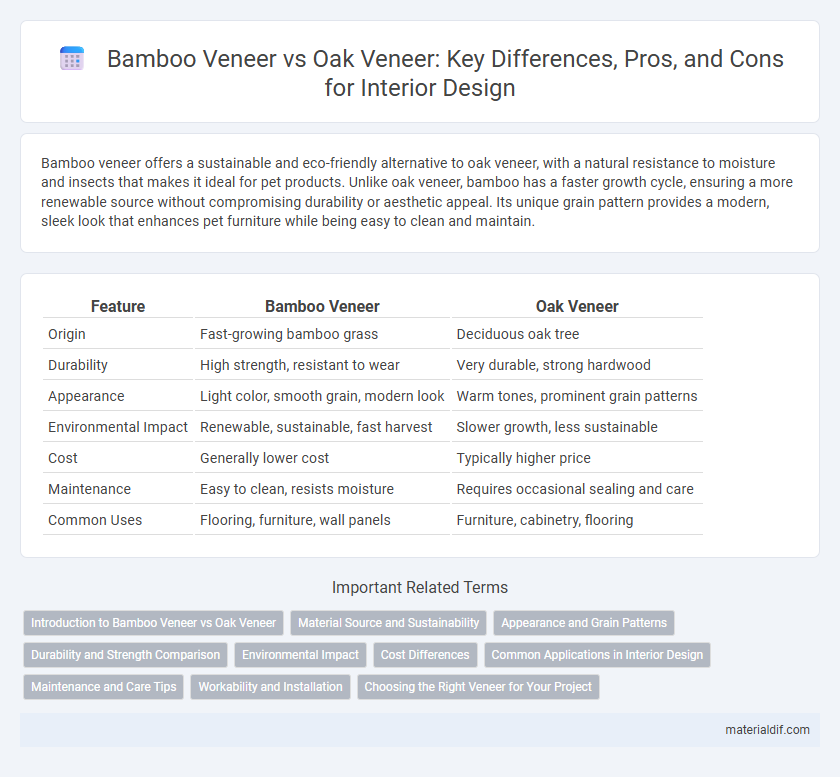Bamboo veneer offers a sustainable and eco-friendly alternative to oak veneer, with a natural resistance to moisture and insects that makes it ideal for pet products. Unlike oak veneer, bamboo has a faster growth cycle, ensuring a more renewable source without compromising durability or aesthetic appeal. Its unique grain pattern provides a modern, sleek look that enhances pet furniture while being easy to clean and maintain.
Table of Comparison
| Feature | Bamboo Veneer | Oak Veneer |
|---|---|---|
| Origin | Fast-growing bamboo grass | Deciduous oak tree |
| Durability | High strength, resistant to wear | Very durable, strong hardwood |
| Appearance | Light color, smooth grain, modern look | Warm tones, prominent grain patterns |
| Environmental Impact | Renewable, sustainable, fast harvest | Slower growth, less sustainable |
| Cost | Generally lower cost | Typically higher price |
| Maintenance | Easy to clean, resists moisture | Requires occasional sealing and care |
| Common Uses | Flooring, furniture, wall panels | Furniture, cabinetry, flooring |
Introduction to Bamboo Veneer vs Oak Veneer
Bamboo veneer offers a sustainable alternative to traditional wood veneers like oak, known for its rapid growth rate and eco-friendly harvesting. Compared to oak veneer, bamboo veneer exhibits a unique linear grain pattern and greater flexibility, making it ideal for modern furniture and interior design. Oak veneer provides classic durability and a warm, rich tone, whereas bamboo veneer emphasizes sustainability and a contemporary aesthetic.
Material Source and Sustainability
Bamboo veneer is derived from fast-growing bamboo grass, known for its rapid renewability and minimal environmental impact, making it a highly sustainable alternative to traditional wood veneers. Oak veneer originates from hardwood trees that require decades to mature, resulting in slower regeneration and greater ecological strain. The innovative harvesting of bamboo ensures a continuous, eco-friendly supply, whereas oak harvesting often contributes to deforestation and habitat loss.
Appearance and Grain Patterns
Bamboo veneer exhibits a smooth texture with uniform, linear grain patterns that feature subtle knots and a light golden hue, providing a contemporary and sleek appearance. In contrast, oak veneer offers a more pronounced and varied grain with distinctive swirls, rays, and knots, contributing to a rich, traditional look with warm beige to medium brown tones. Both veneers showcase natural wood aesthetics, but bamboo's consistent grain and lighter color make it ideal for modern, minimalist designs, while oak's complex grain patterns suit classic and rustic interiors.
Durability and Strength Comparison
Bamboo veneer exhibits superior durability and strength compared to oak veneer due to its dense fiber composition and natural resilience, making it highly resistant to dents and scratches. Oak veneer offers notable hardness and durability but tends to be more prone to moisture damage and warping over time. Bamboo's rapid growth process also contributes to its enhanced structural integrity, positioning it as a sustainable yet robust alternative to traditional oak veneer in furniture and flooring applications.
Environmental Impact
Bamboo veneer offers a significantly lower environmental impact compared to oak veneer due to bamboo's rapid growth rate and renewable harvesting cycles, typically reaching maturity in 3-5 years, versus oak's slower growth that can take decades. Bamboo's ability to sequester carbon efficiently and regenerate without replanting reduces deforestation and soil erosion associated with oak logging. Additionally, bamboo veneer manufacturing generally consumes less water and energy, making it a more sustainable choice for eco-conscious wood product applications.
Cost Differences
Bamboo veneer generally costs less than oak veneer due to faster growth rates and more sustainable harvesting practices, making it an economical choice for eco-friendly projects. Oak veneer prices are higher because of the tree's slower growth cycle and greater demand for traditional hardwood applications. Cost variance can also be influenced by regional availability, with bamboo often sourced from Asia and oak primarily from North America and Europe.
Common Applications in Interior Design
Bamboo veneer offers a sustainable and lightweight alternative to oak veneer, making it ideal for contemporary furniture, wall panels, and cabinetry in eco-friendly interior designs. Oak veneer is preferred for its classic grain patterns and durability, commonly used in traditional furnishings, flooring, and decorative moldings. Both materials enhance aesthetic appeal, with bamboo suited for modern and minimalist styles, while oak complements rustic and vintage interiors.
Maintenance and Care Tips
Bamboo veneer requires minimal maintenance due to its natural resistance to moisture and scratches, making it ideal for high-traffic areas. Oak veneer, while durable, demands regular polishing and protection from excessive humidity to prevent warping and surface damage. Gentle cleaning with a damp cloth and avoiding harsh chemicals are essential for preserving the finish and longevity of both bamboo and oak veneers.
Workability and Installation
Bamboo veneer offers superior workability due to its uniform grain and flexibility, allowing for easier cutting, shaping, and fitting compared to oak veneer, which has a harder, denser structure that can be more challenging to manipulate. Installation of bamboo veneer is often faster and more forgiving, as its natural resilience reduces the risk of cracking or splitting during adhesive application and pressing, whereas oak veneer requires careful handling and precise alignment to prevent damage. Both veneers require similar adhesive types, but bamboo's consistent texture lends itself to smoother bonding and finishing processes.
Choosing the Right Veneer for Your Project
Bamboo veneer offers superior sustainability and rapid renewability compared to oak veneer, making it an eco-friendly choice for environmentally conscious projects. Oak veneer provides unmatched durability, classic grain patterns, and a rich, warm aesthetic, ideal for traditional or high-end furniture. Selecting the right veneer depends on your project's environmental goals, desired texture, and long-term wear requirements.
Bamboo veneer vs Oak veneer Infographic

 materialdif.com
materialdif.com